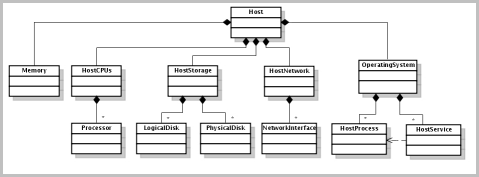How do I delete a model?
|
• |
Only items from ModelRoots can be deleted. |
What are domains?
Example: the Host Model structure
The Host type is the root of the model. Instances of this type are identified by the name property which is typically set with the fully qualified domain name of the host.
Agents can capture host-related data that cannot be stored on the types defined in the common host model. The host model types must not be sub-typed to add support for this data because the types must be known in order for multiple cartridges to share the model. The host model may be extended through composition by adding instances of cartridge-specific types to the detail collection that is exposed on all host model objects.
|
• |
There is a single Memory object attached to a host that is identified by that Host instance. The name property of a Memory object is set with the constant string “Memory”. |
|
• |
There is a single HostCPUs instance attached to a Host that provides host level summary metrics for the processors on a host. The HostCPUs instance is identified by the reference to the associated Host object and has its name set with the constant string “CPUs”. |
|
• |
The Processor type is used to represent a logical CPU that is available on the Host. |
|
• |
There is a single HostStorage instance attached to a host that provides host level summary metrics for the logical and physical disks on the host. The HostStorage instance is identified by the reference to the associated Host object and has its name set with the constant string “Storage”. |
|
• |
The PhysicalDisk represents a disk that is installed in the machine or configured for a virtual machine. |
|
• |
The LogicalDisk type is used to represent a Windows® partition or Unix® filesystem. These types have the same set of observations. |
|
• |
There is a single HostNetwork instance attached to a host that provides host level summary metrics for the network interfaces on the host. The HostNetwork instance is identified by the reference to the associated Host object and has its name set with the constant string “Network”. |
|
• |
The NetworkInterface type is used to represent a network interface that is installed in the machine or configured for a virtual machine. |
|
• |
There is a single instance of the OperatingSystem type attached to a host. The instance is identified by the reference to that Host, and has the following child object types that provide additional details about the operating system (OS): |
|
• |
The HostProcess type captures aggregate metrics for all processes of a given type on the host. The instances complex observation captures the detailed per-process statistics, but that observation may not be produced at all times. |
|
• |
The HostService type captures information on the services configured to run on a Host and their state. |
What is a data source?
If you are building dashboards for monitoring purposes, use the Monitoring data source.
The Data Sources dashboard is where you choose a data source. The default (and only current) option is the foglight-5 data source. Click a data source to display its ID, name, and topology and UI query service names.
|
• |


